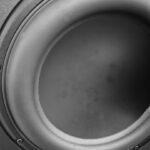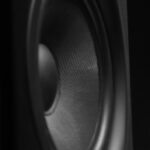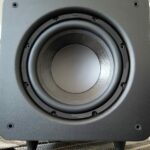Can A Subwoofer Be Placed On A Shelf? (Explained)
Can A Subwoofer Be Placed On A Shelf? (Explained)

Let’s say you’re trying to save space in your home theater and you get the idea of placing your subwoofer on a shelf.
But then you start to wonder if there’s actually any drawbacks in doing so.
Well it’s an interesting thought and one I figured would be worth exploring so lets find out!
Can A Subwoofer Be Placed On Shelf?
No a subwoofer should not be placed on a shelf for a few reasons. While the thought is that it may save space, the downsides are the bass quality may not be as optimal, nearby objects may rattle more, and the sub could fall if the shelf is weak.
Reasons Why Someone Would Place A Subwoofer On A Shelf
The Line Of Thinking That It Saves Space
The first line of thinking is that suspending a subwoofer off the floor in this fashion saves space.
Being that home theater equipment is sometimes large, having enough space to move around without worry of knocking something over can be an issue.
Basically, by placing it off the floor, it opens up more space for other things in the room like different seating configurations for example.
So the notion of being able to save a little space in this way may initially seem like an attractive solution.
However I would absolutely not do this for reasons which we’ll get to.
The Thought That It May Blend In Better With The Room
Like I mentioned previously, home theater equipment can sometimes border on the larger side.
Though there’s ways you can hide some of the equipment, it’s still not always feasible to do so.
Things like tower speakers and subwoofers especially stand out because of how much space they take up.
So there may be a line of thinking that by placing a subwoofer recessed on a shelf, it can make it less noticeable in maintaining the default look of the room.
However there’s a few issues with that in my opinion.
Going back to the original question..
Should You Place A Subwoofer On A Shelf?
Should you place your subwoofer on a shelf?
While a subwoofer can technically be placed on a shelf, there’s a few caveats that immediately spring to mind that gives me pause in recommending doing so at all.
Reasons Why I Think It Shouldn’t Be Placed On A Subwoofer On A Shelf
The Quality Of The Bass May Be Limited
Placing the subwoofer on a shelf might limit the potential sound quality from it.
That’s because getting the best out of a subwoofer’s bass often involves the subwoofer crawl to find the optimal spot for it.
This is where you basically play a test clip, mark the spot in the room where it sounds best to your ears, then place it there.
But by simply placing it wherever without doing so, there’s a real chance that it might not be the spot where it’ll actually sound best.
This could result in bass that seems lackluster or underwhelming when in fact it’s simply its positioning that’s off.
Having dealt with subwoofers for many years now, I can tell you that the sub’s position in a room can have a big effect on its overall sound.
This also goes for its output as well.
The issue with placing the subwoofer up and away is you potentially miss the reinforcement of bass that happens when placing it close to a corner or wall.
Plus the more tactile feeling of bass might be lost since it’s often recommended that a subwoofer be placed on the floor.
This way its output is more impactful, and it can be placed in more locations around the room.
There Might Be More Rattling From Nearby Objects
Something else to consider with setting your sub on a shelf is it may rattle the objects it’s closer to.
By being in closer proximity, there’s the distinct possibility that whatever its next too might rattle louder when the volume is up.
Because bass waves are omnidirectional, that means they travel in every direction and are slower.
The closer you happen to be to the source of that wave, the stronger it’ll be.
So by being closer to any nearby objects, even ones on a wall, it can cause them to rattle more.
This can be distracting and detract away from the experience.
The Shelf Itself Could Break Or Fall
In addition to all of this, the biggest caveat is the shelf or platform it’s on has the potential of falling or breaking — especially if the sub is heavy.
This could significantly damage it if it’s somehow knocked off.
Of course a shelf made of thicker or stronger materials greatly mitigates this issue, but the possibility of the subwoofer falling personally gives me pause with doing this — even if the possibility is remote.
So while you can technically place one on a shelf, it’s important to keep those things in mind.
Alternative To Placing The Sub On A Shelf – Decoupling It
It being on a shelf could theoretically help round off the bass though if it’s too overbearing in its audio delivery.
That’s due to it being physically off the floor.
But a great alternative to achieve the same thing is by decoupling it.
Decoupling the sub basically involves separating it to a slight degree from the floor, so the bass waves aren’t as amplified when they travel.
This can be done through some kind of specialized platform specifically made for that purpose, or even rubber feet that attach to the bottom of the enclosure.
Decoupling can be helpful for both isolating the sound so it isn’t as audible through walls, and improving the accuracy of the bass itself.
Plus you wouldn’t have to worry about it falling off since it’s already on the floor.
These are good options for that in my opinion.
Check Availability Of IsoAcoustics Subwoofer Isolation Stand
Check Availability Of SVS Soundpath Subwoofer Isolation System
Final Thoughts
That about does it does it for this one.
Long story short, floor placement for the sub is typically better as you can better optimize bass output through proper positioning, and there’s less risk for the it falling.
But it’s also understandable why one would want to put it up to save space too.
Until next time, make it easy, keep it simple.
About Me

Jay
Hey everyone it’s nice to meet you. I'm Jay, writer & founder of the site Easy Home Theater. I've been with this hobby of home entertainment for many years now. I decided to create this site to be a helpful resource, and share everything that I've learned from personal experience with you. I also happen to be a huge gamer, lover of all things tech related, and a major fitness buff (love weightlifting)
Contact: Contact Jay
Facebook: https://www.facebook.com/Easyhometheater/
X: https://x.com/easyhometheater
Pinterest: https://www.pinterest.com/easyhometheater/pins/
Instagram: https://www.instagram.com/easyhometheater/
Followit: https://follow.it/easy-home-theater
Bluesky: https://bsky.app/profile/easyhometheater.bsky.social







Leave a Reply